Top 6 Call Center Technology Trends to Watch in 2025

Customer Support Manager - Tier 1

Tags
Share
Great customer service starts with the right tools, and today’s contact center technology offers much more than just handling phone calls.
With advancements like Ai that can anticipate customer needs, automate agent coaching, and speed up QA, modern contact center tools are designed to elevate both customer experiences and agent performance.
Today, contact center software can do much, much more than it used to. (They definitely don't just let your agents have phone calls with customers anymore.) But what should you know about the latest contact center technology?
Having worked in support for almost 10 years, I've seen how these technologies have evolved firsthand. Keep reading to explore the latest trends in contact center technology and how they’re transforming support for both agents and supervisors.
Webinar: Discover how Ai can transform your contact center
Learn how Ai can reduce wait times, boost efficiency, support agents and deliver an exceptional customer experience.
What is “call center technology”?
Contact center technologies refer to specialized software and tools designed to help contact center managers and agents perform their tasks more efficiently. These technologies include call-specific tools such as automatic call distribution (ACD), interactive voice response (IVR), and call recording. Whether you run an inbound, outbound, or blended contact center, these technologies can help you improve communication, collaboration, and productivity—as well as reducing operating costs.
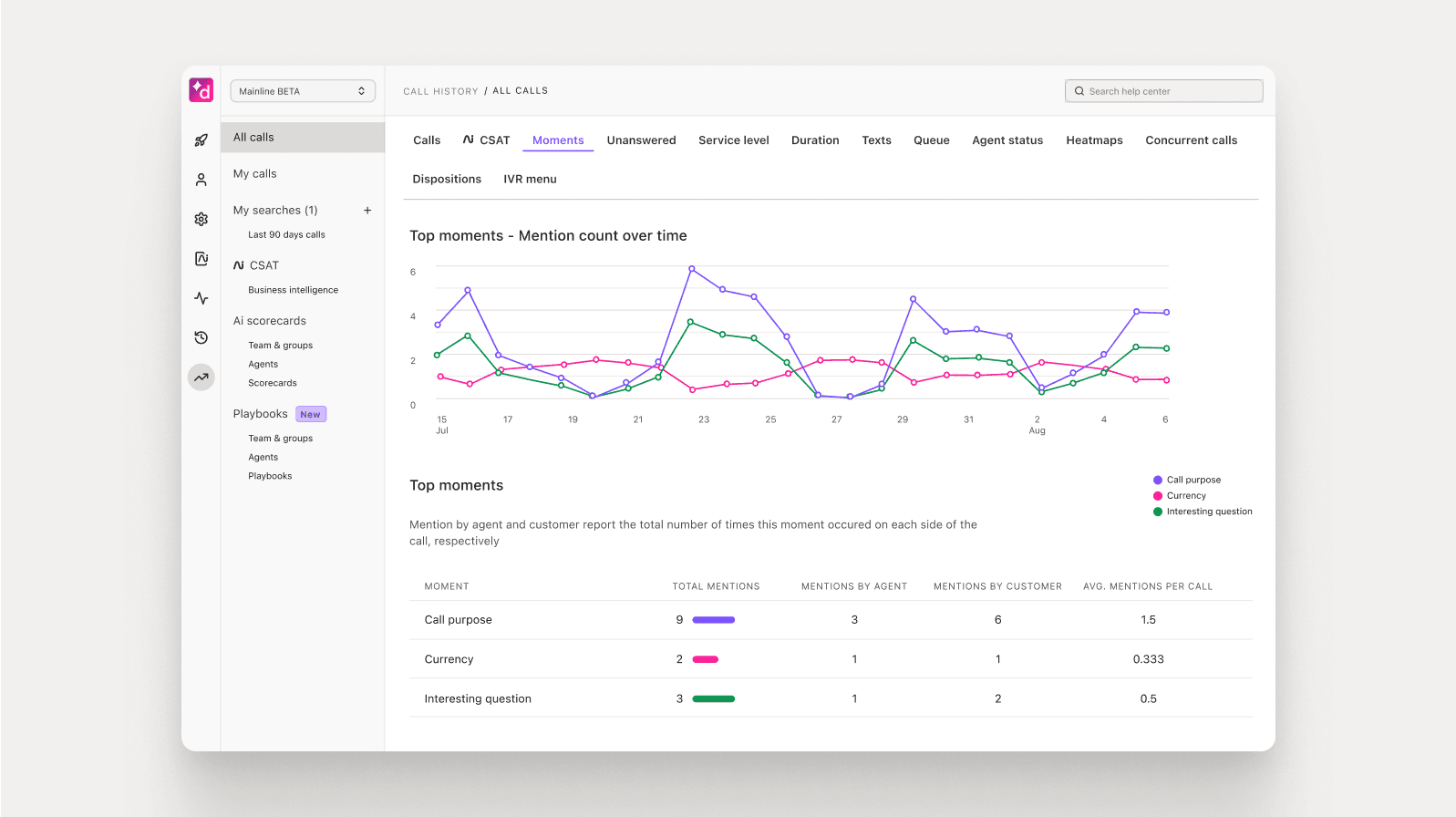
👉 Dialpad tip:
Keeping customers happy is the #1 priority for many contact centers, but it’s important to keep your agents happy, too—and giving them the best contact center technology is a good way to make their jobs easier and ultimately reduce agent churn.
Depending on the size and type of your operation (and of course your budget), you may not actually need every feature that's available. (More on this in just a bit.) In general though, it's better to have a solid, versatile solution.
For example, instead of buying one contact center software, and a separate call transcription tool, and a separate video conferencing app, you could choose something like Dialpad's cloud contact center platform, which gives you all three (and a lot more).
How contact center systems technology changed over the years
Contact center technology has really changed dramatically in recent years, and there are constantly new and exciting developments. (There was a time when we got super excited about things like call routing and auto attendants, whereas now they're pretty much standard with any decent comms system—or they should be!)
Here's a quick snapshot at how far cloud contact center technology has come:
Let's rewind to 1957, which saw the earliest commercial use of a call center. That was when Time Inc. set one up in New Jersey to boost sales of LIFE magazine.
Shortly afterward, when the Private Branch Exchange (PBX) was developed, offices were able to channel all their calls through a few business phone numbers—ditching costly phone lines for each employee.
Further developments that helped call centers grow in popularity include the invention of ACD in 1960, and the 1980s introduction of toll-free numbers.
In the internet age, businesses began to look beyond local phone companies for more advanced calling capabilities and lower costs—which is when Voice over Internet Protocol (VoIP) technology made its entrance.
👉 Dialpad tip:
The invention of VoIP phone systems was a game-changer because it effectively made call center technology accessible to all businesses over the internet—no clunky hardware needed. Today, call centers have evolved into “contact centers,” managing more communication channels like video, SMS group messaging, and even social media alongside phone calls.
From that point on, things have changed even more rapidly, with the advent of cloud technology and the software-as-a-service model. For example, Dialpad Support has monthly and annual plans, and can be deployed from anywhere on any device, all around the world.
Meanwhile, Ai in contact center technology—including machine learning and natural language processing (NLP)—makes it easier to analyze customer behavior and be proactive in giving them the answers they need:
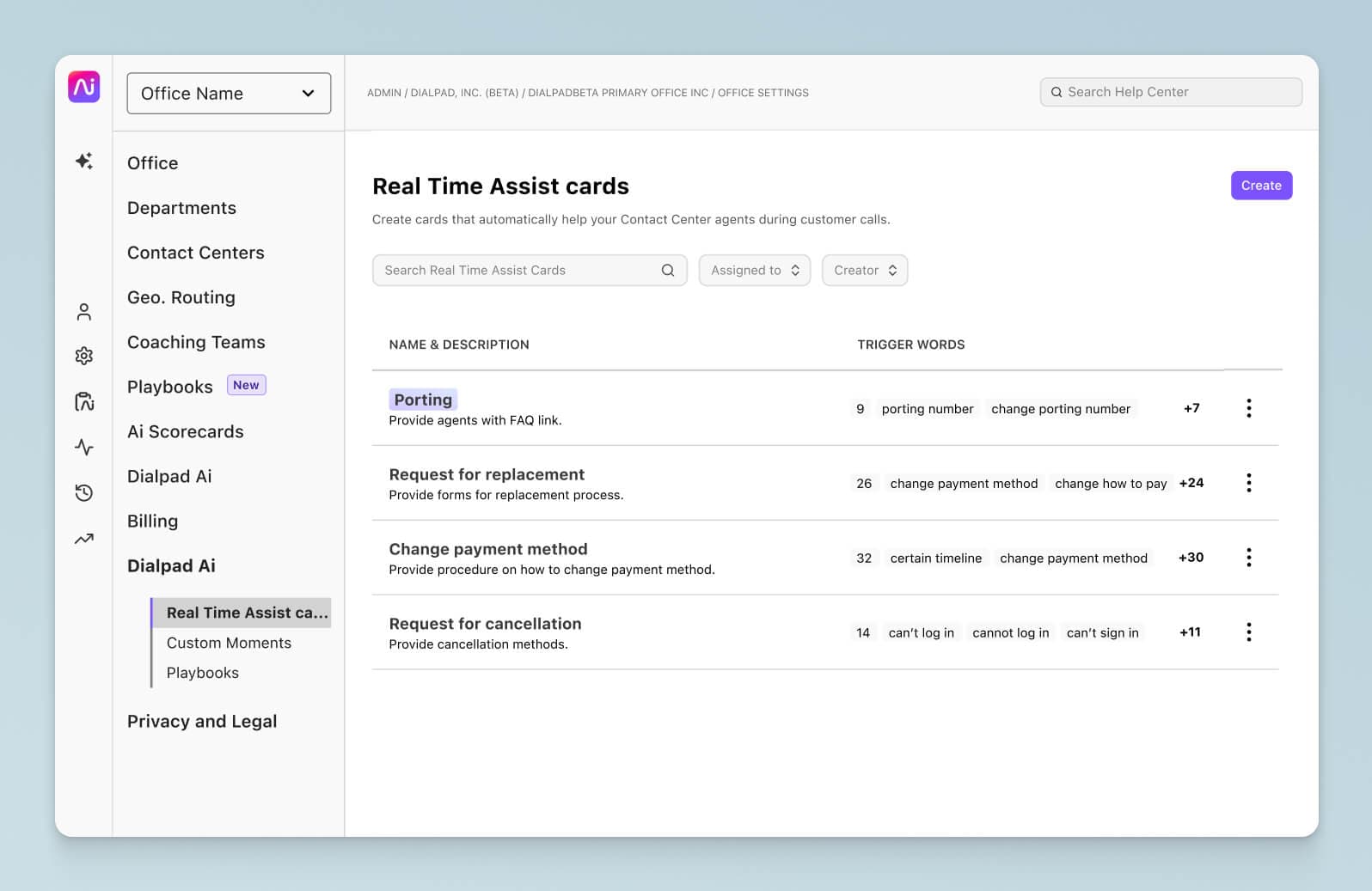
Benefits of call center technology
Call center technology offers many ways designed to streamline operations and improve both agent performance and customer satisfaction. By leveraging these technologies, businesses can not only enhance efficiency but also achieve significant cost savings and provide superior service to their customers.
1. Improved efficiency and productivity
One of the primary benefits of modern call center technology is its ability to automate time-consuming, repetitive tasks. Automated call routing, data entry, and follow-up reminders free up agents to focus on more complex, high-value customer interactions.
For example, tools like Automatic Call Distribution (ACD) and Interactive Voice Response (IVR) can intelligently route calls to the appropriate department or allow customers to resolve issues independently via self-service options. This not only reduces the time agents spend on administrative tasks, but also minimizes wait times, leading to faster call resolution. As a result, call centers can handle higher call volumes, increasing overall productivity without sacrificing service quality.
2. A better customer experience
By integrating features like real-time analytics, CRM systems, and personalized interaction tools, call center technology enables both agents and supervisors to provide more tailored and efficient service. This not only speeds up issue resolution but also helps agents understand customers' needs and histories, improving the overall customer experience and satisfaction.
3. Cost savings
Using call center technology can also help reduce operating costs by minimizing the need for manual processes and optimizing resource allocation. Automation tools reduce the dependency on a large workforce for routine tasks, while cloud-based solutions often cut costs associated with maintaining physical infrastructure.
4. Greater scalability and flexibility
Modern call center technology—especially cloud-based platforms—makes it easy to scale your operations up or down depending on demand. Whether you're growing rapidly or managing seasonal spikes, adding or removing users, departments, or phone lines can be done quickly and remotely. This flexibility supports hybrid and remote workforces, allowing agents to operate from anywhere without compromising performance or security.
5. More accurate data and performance visibility
With built-in reporting and analytics tools, managers gain real-time insight into agent performance, customer behavior, and overall call center health. This level of visibility enables better decision-making, quicker response to issues, and more effective coaching. Plus, predictive analytics and sentiment analysis can surface trends and risks before they become bigger problems—helping you stay proactive instead of reactive.
6 call center technology trends to follow
To be fair, these trends aren’t just on the horizon—they’re already shaping how forward-thinking contact centers operate. While some organizations are still easing into these innovations, the trajectory is clear: technology is fundamentally transforming how we support, engage, and connect with customers. At Dialpad, we believe these trends represent the future of not just customer service, but customer experience as a whole.
(Get a closer look at the call center trends to be aware of.)
1. Ai call center technology
We can't talk about innovation in the contact center space without talking about artificial intelligence. Ai has evolved from being a futuristic concept to an everyday staple in modern contact centers. What began as basic automation—like call transcription or keyword detection—has matured into deeply integrated, real-time assistance that supports both your customers and agents from start to finish.
Today, Ai is helping call centers do more with less—without compromising on the quality of service. It enhances the entire customer journey, from self-service channels to post-call analysis. In many organizations, Ai has already become a virtual team member, answering common questions through smart chatbots, guiding agents through difficult conversations, and helping supervisors coach their teams more effectively.
Take Dialpad Ai, for example. It does much more than just listen in on calls. It also:
Transcribes calls in real time, so agents don’t have to take notes while trying to focus on the customer
Logs action items automatically as they're spoken, meaning next steps are captured and sent to relevant parties without anyone having to manually input them
Pops up Real-Time Assist (RTA) cards to help agents when tricky topics—like billing issues or competitor mentions—come up on a call
Tracks keywords or phrases of interest via Custom Moments, giving supervisors a bird’s-eye view of recurring issues and helping surface process improvements or training needs
Powers intelligent self-service chatbots, improving deflection and first-contact resolution
Generates and emails a post-call summary to attendees on a call
Infers customer satisfaction without needing a CSAT survey—providing insights for up to 100% of customer calls
Highlights performance patterns and coaching opportunities automatically for coaching at scale, without supervisors having to manually listen to random call recordings
Speeds up quality assurance with auto-scoring
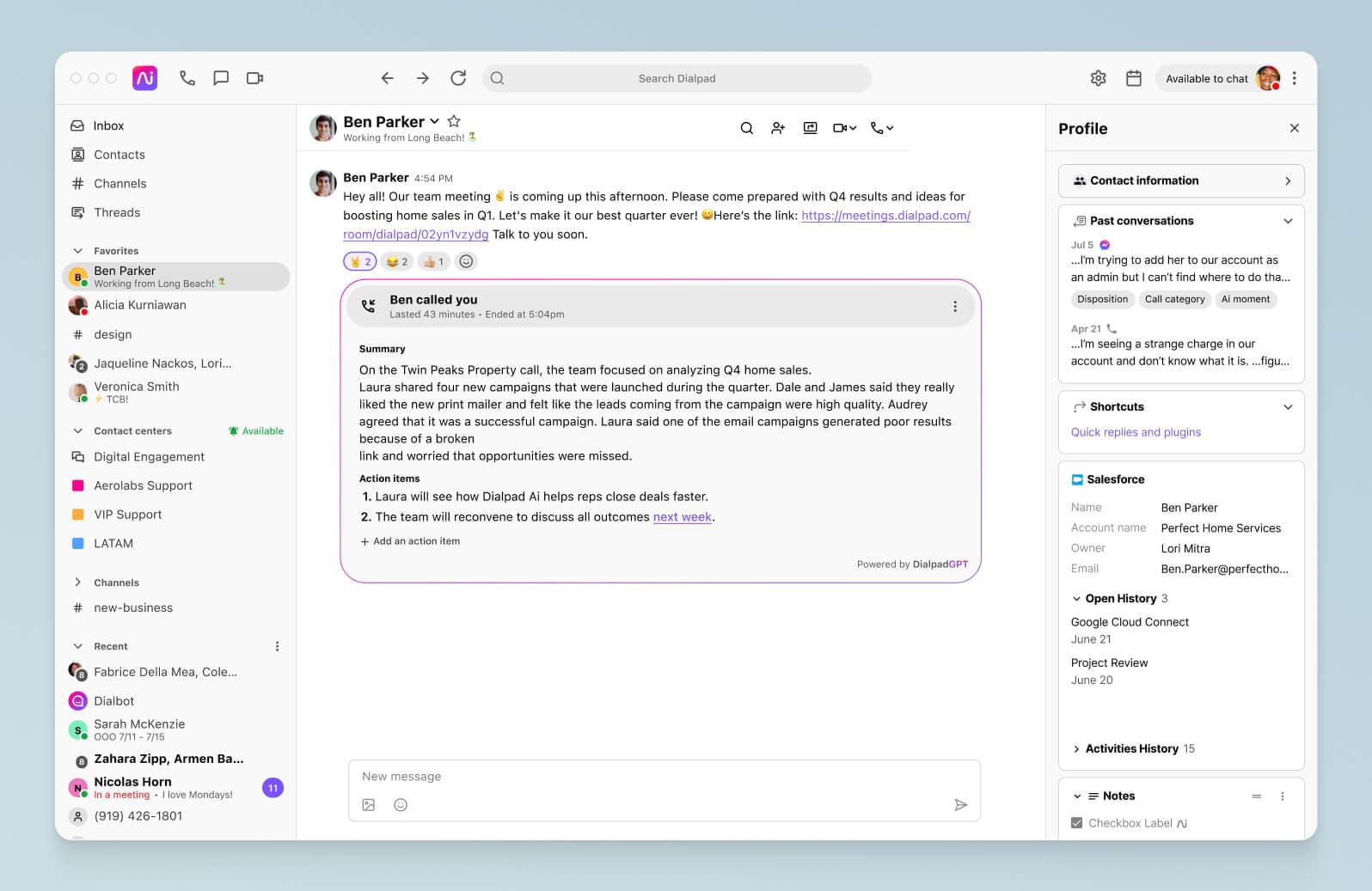
2. Real-time agent assists and automations
On a related note, modern contact center solutions are empowering agents to handle more complex conversations, faster and with more confidence. That’s where real-time assist (RTA) and workflow automation come in.
Real-time assists are rapidly becoming an essential feature in software, using Ai to automatically pop up helpful information as the conversation unfolds. If a customer mentions canceling a subscription or asks about a refund policy, for example, Dialpad Ai can instantly surface the appropriate knowledge base article or talking points for the agent—without anyone needing to type or search manually.
It’s like having a live coach on every call, helping agents deliver consistent, accurate responses—even if they’re new or handling unfamiliar scenarios.
3. Chatbots
Chatbots have evolved into a crucial part of modern contact center technology, driven by the increasing demand for efficient, round-the-clock customer support. In fact, Gartner predicts that by 2029, agentic Ai will autonomously resolve 80% of common customer service issues without human intervention, leading to a 30% reduction in operational costs.
As customer expectations shift toward instant, self-service solutions, chatbots are now more sophisticated than ever, thanks to advancements in natural language processing (NLP) and machine learning.
What sets today’s chatbots apart is their ability to understand context, learn from previous interactions, and provide more personalized responses. Instead of merely spitting out pre-programmed answers, they can engage in dynamic conversations, directing customers to the right information or escalating the issue to an agent when necessary.
Dialpad's Ai-powered chatbot technology takes this even further by not only tapping into FAQ pages but also analyzing unstructured data such as PDF documents and past customer interactions to find the best possible solutions for even the most difficult questions:

Even though Ai-powered call center platforms are constantly fine-tuning their Ai and natural language understanding, keep in mind that chatbots aren't meant to replace humans. To provide the best customer experience, you should always have an easy way for customers to escalate a chatbot conversation to a voice call or video call with an agent.
TL; DR - Self-service should complement your other live communications options.
4. Omnichannel support
Today’s customers don’t just stick to one channel—and they expect your contact center to keep up. Whether they’re calling your support line, texting a question, starting a chat on your website, or messaging you on social media, they want a consistent, seamless experience. That’s why omnichannel support is quickly becoming a non-negotiable for modern call centers.
👉 Quick side-note:
This is in contrast to multichannel support, where every channel's conversations and data exist in silos and it's harder to provide a holistic customer experience. When in doubt, go with omnichannel support.
Dialpad's omnichannel contact center unifies digital and non-digital channels to create more connected customer journeys and seamless interactions between channels. Agents don’t need to toggle between separate tools or tabs to manage conversations. Everything lives in one unified workspace, which reduces friction, improves response times, and minimizes context-switching.
One of the most powerful outcomes of true omnichannel support is the connected customer journey it enables. A customer might start with a chatbot on your website, escalate to a live agent via SMS, and then jump on a quick call to resolve the issue. With an integrated platform like Dialpad, the agent handling the call sees the entire chat history and context from the earlier touchpoints—so the customer doesn’t need to re-explain themselves at every turn. That kind of continuity isn’t just efficient—it builds trust.
Managing multiple channels can also raise questions about workload and agent specialization. If your team is getting overwhelmed, it might make sense to designate agents by channel, or train some to be channel-agnostic, depending on their experience and bandwidth.
(You can create an even better omnichannel experience if you integrate your system with other business software. When tools like your CRM, help desk, and knowledge base connect seamlessly to your contact center platform, agents have all the information they need at their fingertips—from customer purchase history to past support interactions. This level of integration is what turns omnichannel support from a checkbox feature into a real business advantage.)
5. Cloud migration
Whether it's because of mobility or flexibility (or both), more and more businesses are moving toward cloud contact center technology.
There's also the fact that on-premises contact centers tend to be expensive and not very scalable. You have to look after all the equipment yourself, call in an IT team to troubleshoot small problems or install updates, and, if you want to add more users, you'll have to physically wire in new desk phones and potentially servers. All that equipment takes up space, which means you need a large office space (along with all the associated costs).
Cloud-based contact centers are a lot more affordable. You don't need your own servers, as the whole system is housed in the cloud. It's also owned by your service provider—like Dialpad—who takes care of maintenance and upgrades (plus security updates and regulatory compliance). You just pay a monthly or annual fee, and you're good to go if you have an internet connection.
With cloud solutions like Dialpad Support, it's also fast and easy to spin up a new contact center or add more users, and you can operate fully remote or hybrid hot-desking teams to save on office rental fees. What is unique about Dialpad is how scalable it is. Not all cloud solutions make it easy to add thousands of agents to the platform, but Dialpad is one of the very few that can.
6. Workforce flexibility and hybrid teams
The way contact centers operate has changed dramatically in the past few years. The traditional image of rows of agents tethered to desks is being replaced by remote-friendly, flexible teams that can work from anywhere—and contact center technology is finally catching up.
Many of today’s top-performing contact centers are taking advantage of hybrid work models and allowing agents to work both in-office and remotely. But to make that work, you need the right technology:
A cloud-based phone system or contact center software so agents can take calls from any device
Secure access controls to protect customer data
Supervisor tools like live dashboards and call monitoring to keep performance on track, no matter where agents are
Dialpad Support was actually built with this kind of flexibility in mind. Agents can log in from a laptop or mobile app, supervisors can coach and monitor from anywhere, and IT doesn’t have to worry about installing physical hardware.
Plus, workforce flexibility helps with agent retention and hiring (high agent turnover is a trend that isn’t going away anytime soon)—you’re no longer limited to your local talent pool, and offering remote options has become a major competitive advantage in today’s job market.
Types of inbound call center technology
As I touched on earlier, the technology used in contact centers is designed to help managers and agents streamline their workflows, be more productive, and give customers and prospects a better experience. Let's take a look at a few of these in more detail.
1. Cloud-based telephony for scalable, high-quality calls
It's a must-have, and you can't operate without it. But I included this because there are nuances to be aware of, even when it comes to a seemingly basic feature like telephony. Specifically, things like the quality of your calls and intangibles like ease of use and customer support.
For example, with Dialpad, agents and supervisors can have HD-quality VoIP calls over the internet using a desk phone, mobile device, or even their computer using the softphone app. It's also infinitely scalable—you can add hundreds, even thousands, of users quickly, without physically installing equipment or wires.
(Very traditional call centers that focus on telephony rather than omnichannel communications may still use landlines and on-premises PBX, but these are now almost extinct. Most have migrated to cloud solutions or hosted PBX by now because a cloud-based system is just much more flexible—and cost-effective.)
✒️ Vetting contact center solutions?
This RFP (Request for Proposal) checklist covers the essentials to be aware of as you're shopping for a contact center platform.
2. CRM integrations for seamless customer context and more cohesive experiences
Your business probably stores customer data in a CRM (customer relationship management) platform. That's great, but you don't want agents to have to toggle between your phone system and CRM to find relevant information during calls. Because of this, it's better for agents if you can integrate your CRM with your communications platform—like you can with Dialpad.
For example, Dialpad integrates with Salesforce, HubSpot, and more, giving agents instant access to customer details, combined with features like call transfer and click-to-call. That means that even if an agent has never talked to this customer before, they can still quickly see all those past customer interactions and have full context while helping them.
👉 Dialpad tip:
Learn more about CTI (computer telephony integration) dialers, which are an important call center technology that lets agents make phone calls from directly within their CRM and other tools—without having to toggle back and forth between windows or tabs. look out for advanced features like customizable caller ID, predictive dialers, and pre-recorded voicemails for sales teams.
3. IVR and ACD for efficient call routing and self-service
An IVR lets you create a menu of options for callers, with a series of automated prompts. The technology recognizes the responses (based on speech or a touch-tone keypad) and provides simple answers, or directs callers to your knowledge base. It can also invite them to leave a voicemail or request a call-back.
In many cases, IVR helps callers solve their own problems, but it's smart enough to direct them to a human agent if necessary. It's an important call center technology because it's an easy way to automate a potential bottleneck in your customer experience and frees up your agents to handle more complex questions.
ACD and call routing options can automatically distribute calls to available agents based on rules you put in place (such as fixed order, round-robin, or skills-based routing). This improves average time to answer, while directing calls to the most suitable agent saves customers having to repeat information.
4. Real-time and historical call analytics
Contact center analytics are essential for understanding the customer journey and evaluating performance. Most solutions have an analytics dashboard, showing key metrics in real time like staffing levels and call patterns. With Dialpad Support, this is all built right in. You can view historic data, generate reports, and make smarter decisions without having to contact a support or IT team.
Dialpad Support also has useful heat maps showing things like call volume and average speed to answer:
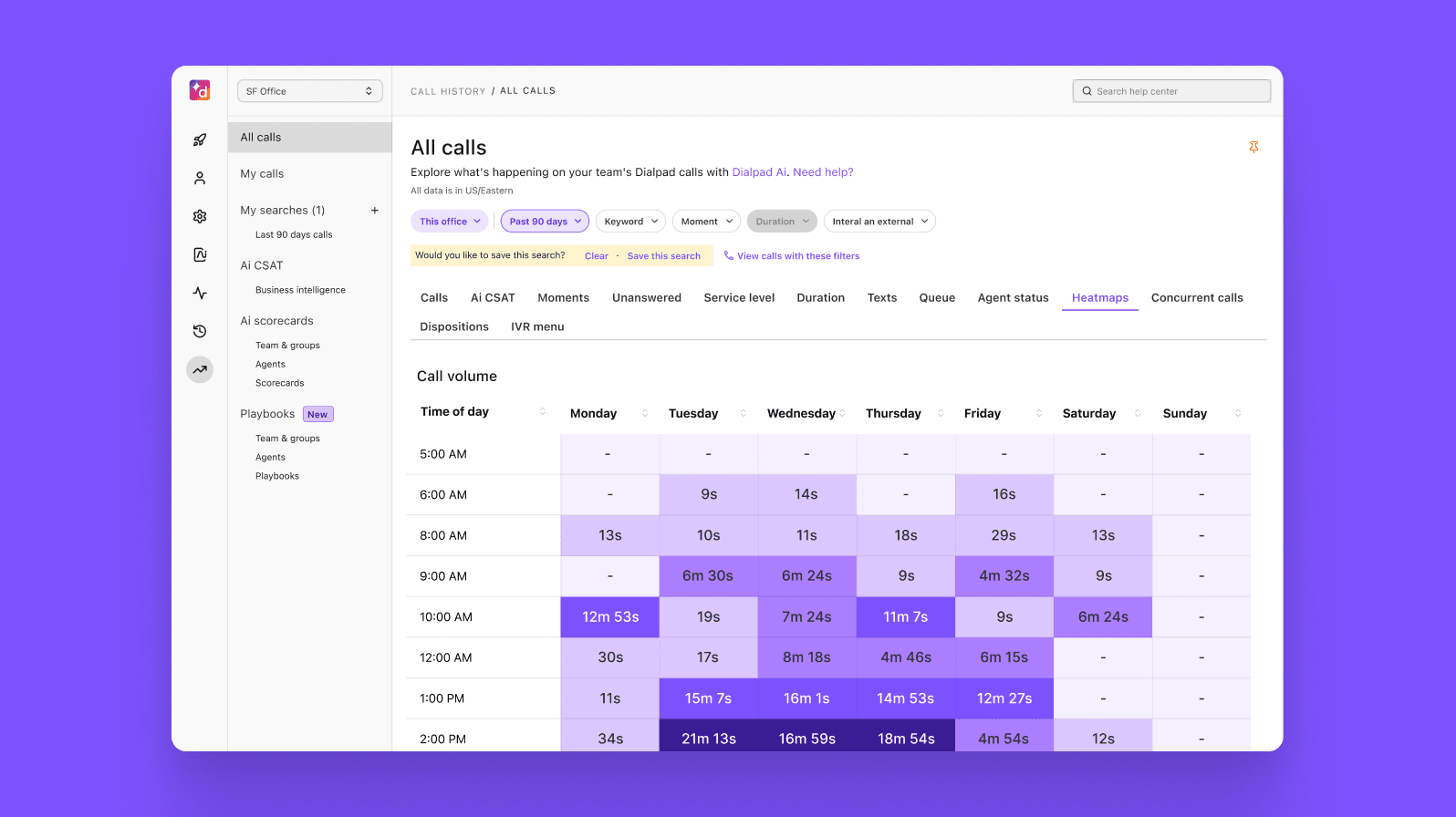
Plus, it also does live sentiment analysis, so managers can quickly scan ongoing calls and step in to help if negative sentiment is expressed.
Last but not least, if you collect customer feedback using CSAT surveys, you probably know that one of the biggest issues with CSAT surveys is the fact that many people don't bother filling them out. That means you get left with only feedback from the most angry and most happy customers.
To give you a more holistic—and accurate—view of customer satisfaction, Dialpad Ai can analyze your customer conversations and generate a predictive CSAT score, so that you have a much larger sample size:

Just remember that there are compliance laws around call recording, and these vary from state to state. Dialpad has a few security-focused features that are designed specifically with this in mind, such as automated notifications and enabling agents to pause recording when sensitive information is being discussed.
👉 Dialpad tip:
As I mentioned earlier, Dialpad also does real-time transcription, which means that you'd have not only the audio recording, but also the transcript and post-call summary handy.
6. Call queuing and callback options to reduce friction for customers
Another essential technology in contact centers is a call queuing feature, which helps you organize incoming calls to reduce wait times or hold times. It's especially important if you have just one main phone number for customers to call.
An auto attendant will place calls in a queue according to your pre-set criteria and play an automated message with an estimated wait time and alternative options. For example, Dialpad offers in-queue callback, where a customer can leave a message and receive a call as soon as an agent is free—while keeping their place in line:
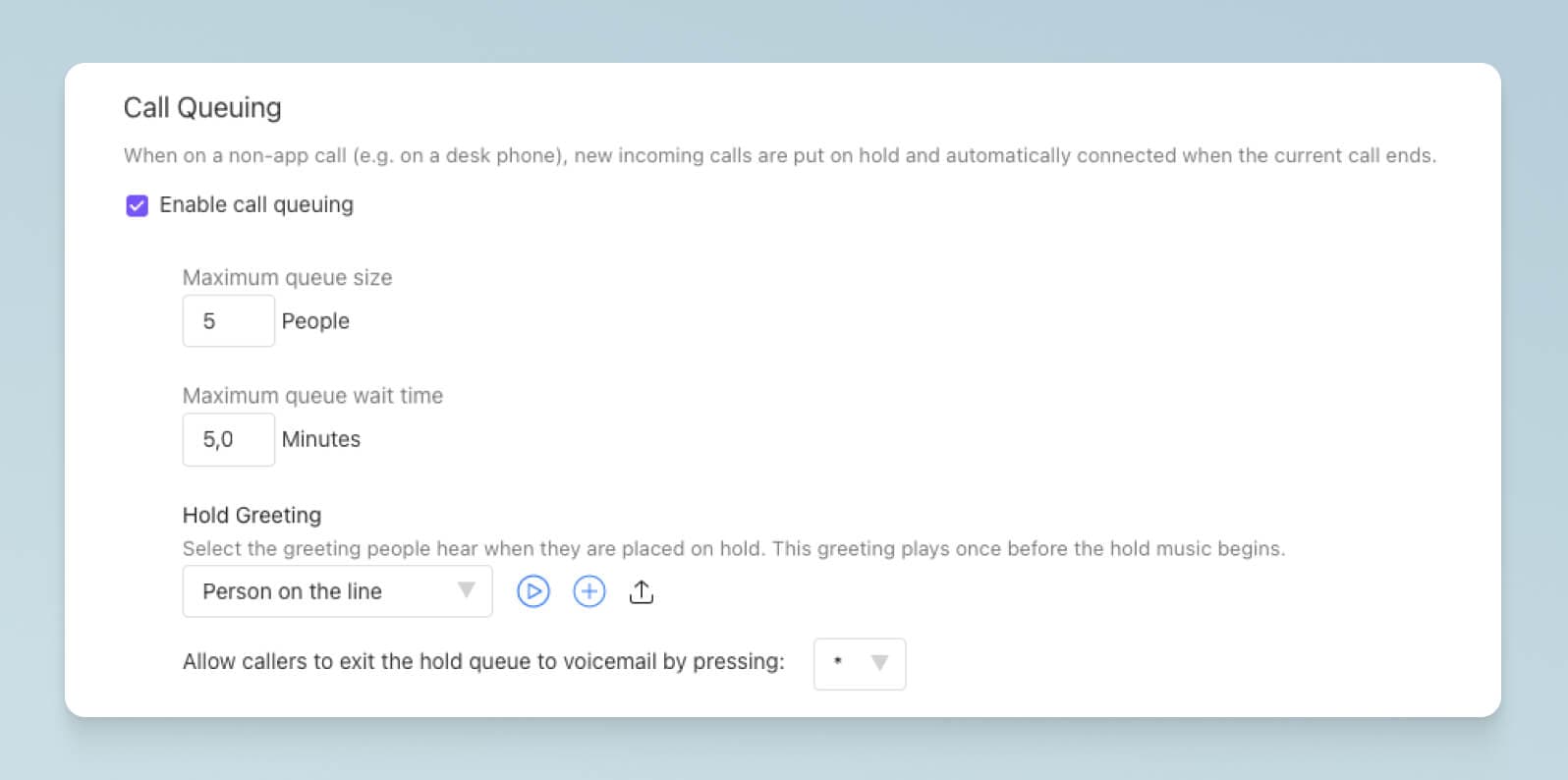
7. Workforce management / quality management for optimized staffing and growth
Some contact center technology solutions incorporate workforce management (WFM) and quality management (QM) functionality as well, which gives you even more control over team staffing and agent gamification.
This includes forecasting contact volumes and scheduling employees accordingly, managing day-to-day operations, and ensuring agents have all the resources they need.
With Dialpad, you can easily add new agents to departments, manage phone numbers, and also remove users right from your online dashboard. It also integrates with Playvox to give you more features like automated scheduling, demand forecasting, and deep analytics.
QM features help managers spot areas for improvement. Dialpad's Playvox QM integration helps managers identify and prioritize areas for skill development, reward agents with points that they can exchange for gifts, and translate customer sentiment into actionable metrics.
Provide a better customer experience with the right contact center technology solution for your business
Now that you know all about the contact center technology basics, you're ready to make some decisions about the future of your contact center—and if you've decided to upgrade to a new system, why not check out Dialpad Support?
Alongside advanced features built right into a user-friendly unified communications platform, Dialpad provides enterprise-grade security, Ai coaching and agent assists, and 24/7 customer support across phone, live chat, and web. Book a product tour now to check it out.
Looking for contact center technology that empowers your agents?
See how Dialpad can help your business deploy hundreds, even thousands of new agents, around the world—and let your team work from anywhere, on any device. Or, take a self-guided interactive tour of the app!
